Matador Network's Blog, page 2287
March 24, 2014
10 signs you're a tourist in SF

Photo: Drew Herron
You’re a new transplant to the city. You’ve got a Giants hat on your head, an ‘artisan’ pour-over coffee in hand, and a sleek new road bike locked up right outside the coffeeshop. You pay too much in rent.
So you must be a local now, huh? Not so fast. Here’s why you’re still a tourist in San Francisco.
1. You say “San Fran.”
Sure, it sounds pretty cool — to people that don’t live in San Francisco. Dropping “San Fran” mid-conversation is a sure-fire way to show others that you haven’t been in town too long. The city doesn’t need a nickname, but if you’re going to go with one, try one of the others: SF or “the City.” People don’t call them “San Di” or “Los Ange,” do they?
2. You don’t layer up.
If it’s nice out, think twice before leaving your house without a sweater or jacket. Once the hour hand strikes 5pm, you’re going to be wishing you had one. When the first gust of cold air cuts through your American Apparel Tri-Blend V-neck, you’re going to be heading in either of two directions: home (to get a jacket) or the mall (to get a jacket). Don’t ruin a good time — layer up.
3. You don’t curb your wheels.
You head to Ikea to furnish your new place. Once you’ve gotten your fill of Swedish meatballs, you drive back to the city with intentions of strolling around Russian Hill. You find a spot on Union and Larkin, nail the parallel parking job, and go for a walk. You forget to curb your wheels and come back to see the worst-case scenario: Your car’s careened into a 2014 Mercedes S-Class. A slightly better scenario? You get an easily avoidable parking ticket. Hopefully you remember to turn your wheel the correct direction next time.
4. You stand to the left.
Ever wonder why people behind you on the BART escalator happen to sigh repetitively every time you’re on it? Move over. Stand to the right. Walk to the left. Simple. Don’t worry — you’ll find yourself sighing at others soon enough. If you’re smart, you’ll bring this information with you to every escalator you come across.
5. You eat at chains.
All these amazing restaurants in the city, and you still go to the Cheesecake Factory in Union Square for dinner? Walk down Valencia Street. Throw a rock in any direction. Go there for dinner. You’ll thank yourself for it.

More like this: Why San Francisco hates Los Angeles
6. You frequent Pier 39.
If you really dig the sourdough, seals, and gimmicky shops (who knew a store that only carries left-handed goods could stay in business?), turn off your phone before heading to Pier 39. It would be a shame if anyone knew that’s what you do for fun. If you really want to wait in a crowd, opt for some warm pastries at Tartine Bakery instead. Please. Entertainment? Stroll over to Castro Theatre and see what’s playing.
7. You line up to ride the cable cars.
So you’re fine with spending excessive amounts of money to ride the cable cars. You’re going to wait in line at the first and last stops, too? That’s okay, but you’re better off hopping on at any other stop that’s not at the beginning or end of the line. You won’t have to waste a large chunk of time, which could be better spent shopping for overpriced goods at Pier 39.
8. You don’t step down on Muni.
If you’re getting off a Muni bus through the back door, don’t just stand there staring at the door waiting for it to open. Once the green light turns on, pay attention. Step down onto the first step to make the doors open. Magic! Take this to heart, or risk being jeered at by everyone within a 15ft radius of your being. One small step for you, one giant leap for everyone trying to get home after a long day at work.
9. You’re going to the beach for a swim.
Yes, San Francisco does have a beach. But, honestly, do you really want to go swimming in a wetsuit or risk hypothermia? Yes!? Polar Bear Club applications are over there.
10. You tell people to visit in June.
June sounds like a great time to visit, but you’re better off telling your friends and family to visit in October when it’s warmer. The months of June and July are cold and foggy. If your friends are into that, maybe it’s time to find new friends. Mark Twain wouldn’t have been too far off if he actually did say “the coldest winter [he] ever spent was a summer in San Francisco.”
Go forth, and be a tourist no longer. 
The post 10 signs you’re still a tourist in San Francisco appeared first on Matador Network.

Girl speaks gibberish in 15 accents
I’VE ALWAYS WONDERED what English must sound like to someone who speaks no English at all. I’m also amazed at how so many people, especially in developing nations, are fluent in their native language and English (and sometimes several more languages), while I can barely get by on “survival” foreign language skills. This girl named Sara, aka “Smoukahontas,” is pretty amazing in that she is able to translate, into gibberish, phrases in over 15 different languages. And I thought speaking Czech set me apart from other linguists…
The post Girl speaks gibberish in 15 accents, demonstrating what they sound like to non-speakers appeared first on Matador Network.

Skiing the greatest snow on Earth
Production notes
Cameras used: Canon 7D, 70D, 5D markII; GoPro Hero 3+, JVC Adixxion
Dates shot: February 12-16, 2014
Music by Senator Hayes
Edited by Yancy Caldwell in Final Cut Pro 7
Stoke notes

Photo: Will Wissman
0:08 – Snowbasin opens up to bluebird skies and 1+ foot of fresh.
0:14 – Powder Mountain, the largest skiable acreage in the lower 48, was closed down due to heavy snowfall and high winds.
0:16 – The view from the top of the tram at Snowbasin.
0:18 – Private cat-skiing at Powder Mountain — the best kept secret in Utah.
0:20 – The tram to the top of Snowbasin delivers 3k+ of vertical goodness.
0:22 – Glorious views of the Great Salt Lake off the backside of Snowbasin.
0:28 – A large avalanche crown from ski patrol bombing, Sundown sidecountry, Powder Mountain.
0:37 – Wyatt Caldwell blows up a massive blast of The Greatest Snow on Earth in the trees at Powder Mountain.
0:46 – Utah local Hayden Price plows through 2+ feet of fresh in the Alta sidecountry.
0:50 – Reggie Crist powder POV in the Utah backcountry.
0:55 – Alta base area timelapse as Mt. Superior swirls in the evening light.
0:58 – Treetop POV shot by Will Wissman on a Snowbird sidecountry run.
1:00 – Kitt Doucette enjoys first tracks off the top of a Snowbasin ridgeline.
1:13 – Timelapse of a brief clearing of clouds from the top of Powder Mountain.
1:15 – Timelapse of Mt. Superior shot by Will Wissman.
1:17 – Carlo Travarelli drops cliff in Utah backcountry.
1:20 – Yancy Caldwell pops off a snowbank on a snowed-in day atop Powder Mountain.
1:25 – Cat-skiing at Powder Mountain is an all-time experience.
1:26 – Wyatt Caldwell blasts through the deepness at Powder Mountain.
1:38 – Pat Lee and Yancy Caldwell get barreled in The Greatest Snow on Earth, Powder Mountain.
1:45 – Kitt Doucette gets him some in the Powder Country, PowMow.
1:50 – Reggie Crist explains why skiing in Utah is like nothing else.
2:00 – Tony Rossi bags some airtime on a pow day at Snowbird.
2:10 – Sam Cohen drops a massive peak in the Utah backcountry.
2:20 – Will Wissman charges pow in the Utah backcountry.
2:28 – Patrick Lundin, Powder Mountain’s marketing director, hard at work.

 This post is brought to you by Utah, home of The Greatest Snow On Earth®. With 11 ski resorts less than an hour from Salt Lake City International Airport, there’s plenty of powder for the perfect ski vacation.
This post is brought to you by Utah, home of The Greatest Snow On Earth®. With 11 ski resorts less than an hour from Salt Lake City International Airport, there’s plenty of powder for the perfect ski vacation.
The post What it looks like to ski the greatest snow on Earth appeared first on Matador Network.

30 super trippy buildings [pics]
These architectural oddities range from super-modern skyscrapers to organic treehouses, but all share the common theme of being super trippy.
The single biggest architectural project here is Brasilia, the capital of Brazil. The entire downtown was designed by Oscar Niemeyer in the late 1950s and had a totally futuristic style, that to this day remains almost UFO-like. But there are lots of individual buildings and even small dwellings that blend the lines between art and architecture for their curvilinear forms or way they flow into the landscape.
How do the spaces you inhabit affect you? What are the strangest buildings and spaces in your area? 
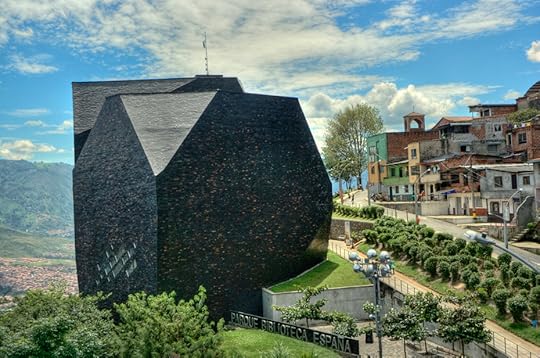
1
Biblioteca España
Set on a hilltop in Santo Domingo near Medellin, Colombia—an area that was heavily affected by violence and drug trafficking in the 1980s and 1990s—Biblioteca España was built as part of an initiative to enhance urban development and to provide more opportunity to the city's poorest residents.
Photo: danjeffayelles

2
Dutch cube houses
Netherlands residences shaped like cubes, the
Kubuswoningen, or Cube Houses, are a set of innovative houses designed by architect Piet Blom in 1984 in Rotterdam. There are 38 small cubes and two so called "super-cubes," all attached to each other.
Photo: Andrea de Poda

3
Vortex House
"Vortex House" was an art installation in Montrose, Houston, on a house awaiting demolition. Unfortunately, the house has already been torn down.
Photo: Michael Cote

See more like this: 30 of the world's most beautiful bridges

4
Dalat's Crazy House
This strange hotel was designed by Dang Viet Nga, an avant-garde artist who got away with more weirdness than she otherwise would because she was the daughter of Ho Chi Mihn's successor. It's known as "Crazy House."
Photo: upyernoz

5
Seattle Central Library
The Seattle Central Library was built in 2004 to be an inviting and functional public space. Its "Book Spiral" displays the library's entire nonfiction collection in one continuously winding run, enabling library-goers to peruse the 4-level section without being interrupted by stairs.
Photo: Stephen J. Friedman, MD

6
Krzywy Domek
This fairytale-inspired building is part of a shopping center in Sopot, Poland, and its name means "little crooked house."
(via)
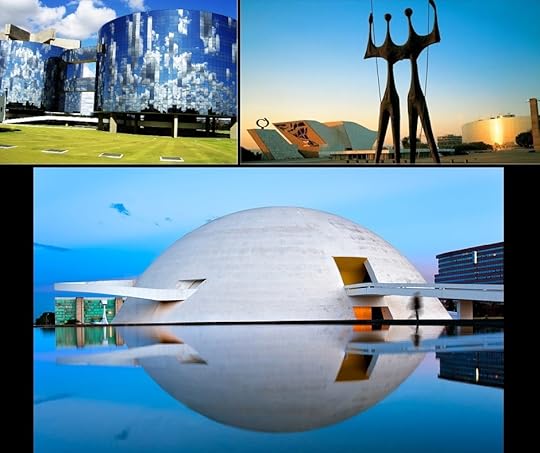
7
Brasilia
Master architect Oscar Niemeyer (December 15, 1907 – December 5, 2012) was among the most influential designers of all time. When Brazil decided to build its new capital city Brasilia in a spacious inland area, he had the rare opportunity to design and build an entire interlinked downtown which included the congress, supreme court, and cathedral.
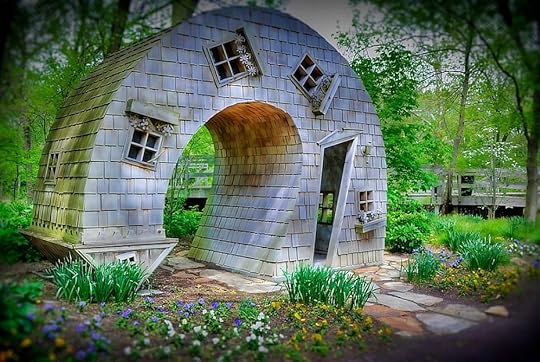
8
Twisted House
The Twisted House in the Indianapolis Arts Center in Indiana was created by John McNaughton of Evansville. It is made of cedar.
Photo: Serge Melki

9
Upside down house
An upside down house in Trassenheide in Germany. Even the furniture inside is stuck to the ceiling.
Photo: Backkratze
Intermission

Amazing libraries around the world [PICS]

15 super unique libraries around the world [PICs]

30 of the world’s most beautiful bridges [PICs]
[image error]
10
Hotel Marqués de Riscal
This is a smart fusion of award-winning wine and avant-garde architecture. Spain’s Rioja vino is a favorite for many, and a visit to the region makes for an interesting trip in rural Spain, especially if staying at Hotel Maqués de Riscal. The hotel’s flamboyant style is signature Gehry, who has left his artistic imprint on other parts of the country as well.
Photo: HaSHe
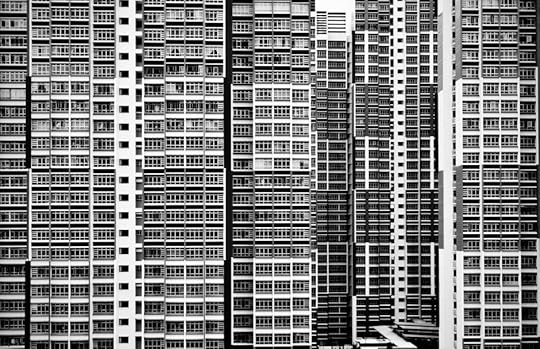
11
Trippy Singapore density
The sheer density of Singapore's buildings warrants its spot on this list.
Photo: Aiste Stancikaite

12
House Attack
While this traditional home wedged into the roof of Vienna's modern art museum may look perfectly residential (except for being upside down), it's an art piece designed by Erwin Werm.
(via)

13
Donut hotel
Recently built in Guangzhou, China, this enormous glowing donut is actually a hotel. It was designed so that the reflection of the building would form a number 8, a lucky number in Chinese culture.
(via)

14
Dancing House
Designed by Frank Gehry and supported by Vaclav Havel, this government administrative center in Prague looks like someone melted half an office building and smooshed it into the other half. It's on the Czech 2,000-koruna coin.
(via)
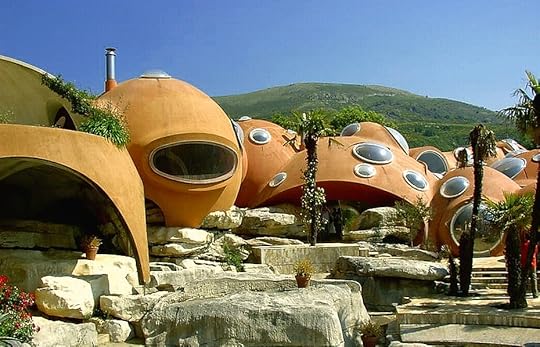
15
Bubble houses
The "Maison Gaudet" bubble houses in the south of France are designed by Antti Lovag, an anti-conformist architect with no diploma who built this residence after an experimental model in 1969.
Photo: Muracciole Jean-Marie
Intermission
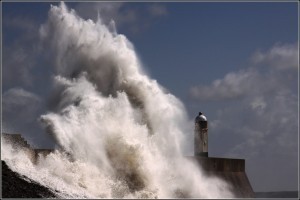
23 iconic lighthouses around the world [PICs]
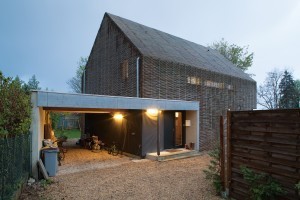
Low eco-footprint houses in rural France [pics]
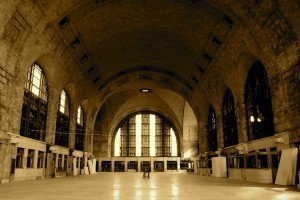
Abandoned train and subway stations of the world [PICs]

16
Atomium
This fantastic building was built in Brussels for the 1958 World's Fair. Standing 335ft tall, the structure lacks sufficient external support, so only six of the nine spheres are open to the public.
(via)

17
Casa Batlló
This stunning modernist building in Barcelona was designed by Gaudí for a family home but is now used primarily for a museum and event space.
(via)
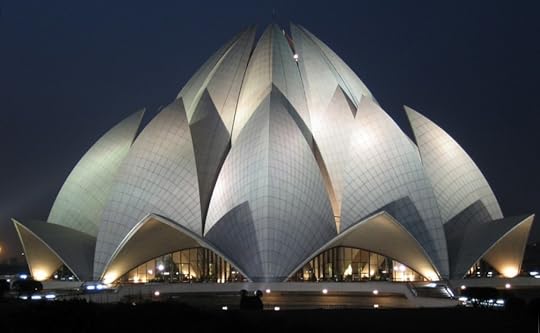
18
Lotus Temple
A Bahá'í temple in New Delhi, India, the Lotus Temple has drawn over 50 million visitors since it opened, making it one of the most visited buildings in the world.
(via)

19
Montaña Mágica Lodge
This Chilean eco-hotel is located in the middle of a UNESCO-preserved rainforest and is built inside a manmade volcano that erupts water from the top, which flows down the sides.
(via)

20
Nautilus House
This amazing shell-shaped house was built as a family home in 2006 and is full of natural glass mosaics that reflect colored light into the rooms.
(via)

21
Free Spirit Spheres
Free Spirit is a campground with style—you stay in suspended spherical treehouses in the temperate rainforest of Vancouver Island.
(via)

22
Waldspirale
This German residential building complex looks like an organic layer cake and contains 105 apartments and a small courtyard with an artificial lake. It also has a green roof.

23
Lyons Airport Train Station
Lack of public transportation to nearby Lyons makes this beautiful train station difficult to use for anyone who isn't hopping a TGV train to the Alps, but it's directly attached to the airport, making it the first impression many tourists get of southern France.
(via)

24
Motisons Tower
The Motisons Jewellers building in Jaipur is designed to look like a lotus flower and illuminates at night.
(via)

25
Bull Ring
The Birmingham Bull Ring is a shopping center and gathering place, built on the same place where markets in Birmingham, UK, have been held since 1154.
(via)

26
Gibbon Treehouse
This treehouse in Laos sleeps up to 8 people, and somehow has sufficient enough plumbing for a kitchen, a bathroom, and a shower. The Gibbon Experience runs these guesthouses, all of which are connected to one another with zip lines, and all profits are reinvested into conservation projects within the reserve.
Photo: Christian Haugen
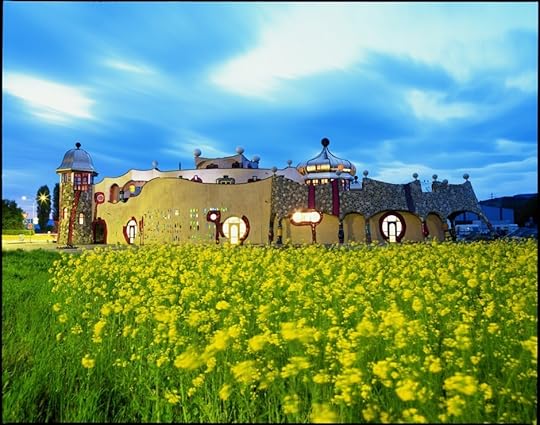
27
Markthalle Altenrhein
This nature-inspired fairytale castle is actually an event center and museum in the tiny town of Staad, Switzerland.
(via)

28
Dynamic Tower
The Dynamic Tower is a prospective 80-floor moving skyscraper in Dubai that will change shape as it rotates. It will be powered entirely by wind turbines and solar power and is still in the planning stages.
(via)

29
Olympic Stadium
Montreal's Olympic Stadium was built for the 1976 Olympics and has the largest seating capacity of any Canadian stadium. While the design is impressive, the workmanship is shoddy, and chunks of the building's concrete have been falling off since shortly after its completion.
(via)

30
Guggenheim Museum
Frank Gehry's modern art museum in Bilbao, Spain, is often lauded as one of the most fantastically designed buildings in the world.
(via)
The post 30 of the trippiest buildings around the world appeared first on Matador Network.

March 23, 2014
How stupid can this college be?
RECENTLY, I WROTE an article all about why Charleston, South Carolina, is the best place you could possibly go to college. One of the reasons I listed was about how liberal Charleston is, especially in terms of our LGBT, and African American populations. I’m sad to say, I was wrong on that point.
Recently, Lieutenant Governor Glenn McConnell was chosen to become the College of Charleston’s newest president. He has zero background in academic administration, and supports the Confederate battle flag flying on South Carolina’s Statehouse grounds. He participates in Civil War reenactment as a “hobby,” but the credibility of such a pastime is questionable, when photos such as the one above — in which he is dressed as a confederate soldier, flanked by some slaves — are publicly displayed.
CofC has done some pretty shitty things in the past — they once shut down a sex toy party that was going to raise funds to help domestic violence victims, because of some stupid, outdated ordinance about it being “illegal to have pornography within one mile of a church” (there are churches on every corner in Charleston) — but this move is honestly insulting in so many ways. The two other leading candidates were both strong, with legitimate university administrative backgrounds. Jody Encarnation is a retired Harvard University professor and CofC alumni, and Martha Saunders was former president of the University of Southern Mississippi.
No one would have thought twice about electing Barack Obama if one of his policies included flying the Black Power flag on Capitol Hill. No one would have taken the President of Germany seriously if a photo of him dressed as a Nazi, between two concentration camp reenactment victims, became public. Why is it acceptable for a university, which is supposed to set a precedent for the state, and encourage students to enroll based on the fact that it is a safe, progressive, discrimination-free environment, to choose such an ill-fitting leader?
What upsets me the most, is the complete disregard CofC had for its faculty (only 11% of which support the decision) and student body. Hundreds of students protested McConnell’s candidacy on a daily basis. They exercised their democratic rights, writing letters, sending out petitions, holding forums and more. And yet, McConnell was “unanimously chosen” by the administrative board at CofC. It was a move to secure future funding for the school, but as alumni withdraw their yearly donations, and new student enrollment drops, they are going to need a lot more than what McConnell’s supporters can offer
The CofC Alumni catchphrase is #CantHideThePride. Well fuck that yo — whatever pride I once had for my alma mater, is completely gone. 
The post How stupid can this South Carolina college be? The answer: Very appeared first on Matador Network.

Why you shouldn’t work 9-5

Photo: Joshua Hoffman
IT’S 7PM ON A MONDAY NIGHT. You have everything open from Facebook to TechCrunch on your browser tabs, except for the work you actually need to get done. You return to your lists of to-do’s for the day, only to realize you haven’t finished a single task since 1pm.
Let’s face it, we’ve all been there.
Why the 9-5?
The average American today works 8.8 hours per day (Bureau of Labor Statistics), but how effective are we really working those 8.8 hours per day? Before we dig in, I decided to do some background research about how the 9-5 came to be in the first place.
The answer comes from a man named Robert Owens, who started a campaign during the Industrial Revolution. Back then, 14-hour days were the norm in order to maximize the output of companies’ factories. Owens bravely advocated the notion that people should not be working for more than eight hours per day.
His famous slogan was: “Eight hours labour. Eight hours recreation. Eight hours rest.”
The 8-8-8 rule soon became the standard when Ford implemented the eight-hour day with Ford Motors Company in 1914. Despite the doubts he faced, the results were astonishing: “With fewer hours worked by the employees and double the pay, Ford managed to increase his profit margins by two-folds. This encouraged other companies to adopt the shorter, eight-hour workday as a standard for their employees.”
Bottom line: There’s no scientific or well-thought-out explanation of why we work eight hours per day. It’s simply a standard that has been passed on for over a century, used to run factories most efficiently.
Work smarter. Not longer.
Time has become a measure for productivity because it’s an easy metric to measure. We constantly try to jam in more hours during the day because we feel like we accomplished something by the end. But time is a vanity metric when it comes to measuring productivity.
In today’s creative economy, how long we work per day isn’t what’s important. It’s what you do with the time you have. According to Sara Robinson, referring to various studies done by businesses, universities, and industry associations:
“On average, you get no more widgets out of a 10-hour day than you do out of an eight-hour day… [In fact], every hour you work beyond 40 actually makes you less effective and productive over both the short and the long haul.”
Long hours, in other words, are often more about proving something to ourselves than actually getting stuff done.
With this in mind, I’ve been on the hunt for ways to get more done during my day. After experimenting with various tips and tricks, here are five things that have been working for me:
List your three most important tasks.
Before you leave the office, list three tasks for the next day that will be the most impactful to what you are working on. Tip: If you already have a to-do list, pick the task that’s on the bottom of your list or the one that you’ve been avoiding the longest, and put it on the top.
Work in 90-minute intervals, then take breaks.
Rather than looking at your day as a six- or eight-hour workday, break your day up into three or four 90-minute chunks (1 task per 90-minute interval). Take breaks in between to go stretch, run, flirt — whatever you need to get your mind off work for a period of time.
Give yourself less time.
Apply the Parkinson’s Law for everything you do during the day. As Tim Ferris puts it, “a task will swell in (perceived) importance and complexity in relation to the time allotted to complete it.” Basically, if you have eight hours to do something, you’ll take all eight hours for something that can be done in less time.
Bunch similar tasks together.
Whether it’s replying to emails, making phone calls, or sending out tweets, do them in bunches. Multitasking is the devil, and you do not want to waste your mental energy going back and forth on different tasks.
Ask for help.
Emphasize what you’re good at, but don’t waste time trying to correct weaknesses. If you’re stuck on something, take five seconds to ask a neighbour or phone up a friend who may know the answer. Start leveraging your network, and it could save you hours of stress and time.
I’ve personally felt much happier after implementing these few tricks, and as a result it has only improved the work I do in the office. I’d love to know how these tips work for you. Feel free to recommend them to anyone you think would find them useful. 
This post was originally published at The Growth List and is reprinted here with permission.

March 22, 2014
GoPro Grizzlies
THE INNOVATIVE USE of GoPro technology has brought visual media to an entirely different level. I love how non-invasive it is, to the point that this bear even tries to snack on it. Getting to view animals and the outdoors in such an intimate yet natural way is entirely possible now. These bears certainly look like they are having the time of their lives, and I’m happy I get to see a part of the world that is so different from the city streets I encounter every day. 

This bird just learned to fly [vid]
“Bigbird” is the name of a pelican who, after a storm, was abandoned by his flock and washed ashore in Tanzania, no longer able to fly. So the staff at Greystoke Mahale Camp, which runs safaris usually known for their encounters with chimps, strapped a GoPro camera onto his beak, facing back at Bigbird, and ran up and down the beach flapping their arms to try and get him to remember how to fly.
I watched it for the first time and thought, “How is this possibly helpful?” and “Isn’t that camera on his beak probably making this more difficult for him?”
But then he takes off, and the view is incredible. Give it a watch. 

March 21, 2014
How to eat ramen like a pro

Photo: MrGaryLarson
JAPANESE RAMEN ラーメン is the type of food anyone can eat. It’s affordable, simple, and doesn’t have any pretense. Originally sold as a casual meal for factory workers, it’s now become a cultural phenomenon. Wandering the narrow back streets of Tokyo, or maneuvering through world-class shopping malls, you’re spoiled for choices.
Of course, you can also expect the cacophonous noises of an entire ramenya full of slurping people, exclusively Japanese-speaking staff, and confusing vending machines you must use to place your order…. Ramen shops can be quite intimidating, especially for first-time visitors. Here’s how it’s done:
Walk in like a pro.
Ramen shops aren’t the place to hang out with friends, enjoy a few beers, or have a romantic date. They’re the place where people come, order, pay, eat, and leave. You start your experience by joining a long queue outside the shop. However, the ‘eat and leave’ custom guarantees your wait time will not be insanely long. Look for a vending machine near the entrance, either outside or inside. If there’s a machine, select your dish and drink, pay, and grab a ticket. If there’s no machine, you’ll need to pay at the counter. Once inside, grab the first available stool.
Ramen shops are usually manic, so if you’re a party of two or more, it’s unlikely you’ll get to sit together. Once you’ve secured your seat, watch the chefs crafting your bowl of ramen right in front of you, usually ushered by the head noodle chef, constantly yelling as he pulls noodles from boiling water, shaking them. Most ramen shops will provide you with a glass of tap water, which will be automatically refilled once empty. However, if that’s not the case, look for a jug of water, or a dispenser somewhere in the shop, and help yourself.
Once you finish eating, watch other customers as they leave to see if the shop expects you to put your empty bowl on the upper counter. Just do as they do, and you’ll be fine. Leave as soon as you’re done.
Order like a pro.
There’s a popular culinary equation in Japan: ramen = broth + noodles + toppings. Broth is the most important part of ramen — it’s the body of the dish and takes days to prepare. Ramen chefs train for a very long time to be able to prepare a good bowl of fish- or meat-based broth, and it can take up to 60 hours to boil a perfect one.
There’s an overwhelming variety of different broths. With vending machines featuring a small image of the dish with kanji explanations, you’re bound to fail to order what you actually want. To make the right decision, you should know the basic broths, which you can easily recognize visually:
Tonkotsu 豚骨 (white, milky, pork-based soup)
Shoyu 醤油 (brown, transparent, soy-sauce-based soup)
Miso 味噌 (brown, non-transparent, miso-based soup)
Shio 塩 (transparent, salt-based soup)
All ramen dishes come with noodles: thick, thin, ribbon-like, straight, wrinkled, long, or short, all made from four basic ingredients: wheat flour, salt, water, and kansui (a type of alkaline mineral water). Making noodles with kansui lends them a yellowish hue, as well as a firm texture.
Now it’s time to get creative with the toppings. The most popular ramen toppings include:
Chashu チャーシュー (barbecued or braised sliced pork belly)
Narutomaki 鳴門巻き (cured surimi produced exclusively in Japan, a delicacy made from white-fleshed fish)
Tamago 卵 (soft-boiled eggs used specifically for ramen)
Negi ネギ (spring onion)
Nori 海苔 (dried seaweed)
Moyashi もやし (soy sprouts)
Menma メンマ (fermented bamboo shoots)
Slurp it like a pro.
Lean forward towards your bowl and support it with one hand. Take a minute to indulge your senses with the sights and smells coming from your perfect bowl of ramen. Then, grab your chopsticks and start by tasting the noodles, which draw up all the flavors from the broth. Coat them in the broth and slurp, as loudly as you can. Sink the chashu into the soup and leave it to enjoy later. The more soup it absorbs, the softer it gets. Keep slurping the soup. Know that slurping your ramen is a must with the Japanese. Not only is it the ideal way to enjoy a bowl of ramen, but it can be insulting to the chef if you eat your ramen too quietly.
Once you finish the last drop, put the bowl down and say: Gochisousama deshita ごちそうさまでした (Thanks for the meal). 
This post was published in its original form at Go Abroad, and is reprinted here with permission.

The new frontier: Urban exploration
THE TRADITIONAL CONCEPTION of “exploration” has always looked “out there”: sailing around the world, trekking to the South Pole, summitting the world’s tallest mountains. But every time a legendary explorer went out to confront those frontiers, to push past them, the rest of humanity was back at home, constructing the infrastructure that makes our modern lives possible.
Like any complex system, crafted over long periods of time and often with short-sighted planning, redundancies developed. Sites were built, scrapped, covered over, and built again. Entire substrates of our biggest cities are closed off and largely forgotten. At the same time, you have restricted-access facilities that are used and depended on every day by millions of people: storm drains, power stations, construction cranes, skyscraper ledges, utility tunnels. A built landscape, created by humans but kept out of sight of all those who live within it.
Enter the urban explorers, men and women from all over the globe intent on bypassing the safeguards, hopping the fences — intent on practicing the art of intrusion — in order to chart and document this new frontier. Equipped with enviable photo and video skills / equipment and a means of distribution via social media, they’re showing the world what’s been right under our feet this whole time.
Watch the video above, Art of Intrusion (footage by Bradley L. Garrett, edited by Matador’s Eric Warren), and then check out the photo galleries linked below that pay homage to the urban explorers, placehackers, free climbers, and others who are pushing the boundaries on the edge of this new frontier.
Meet the man infiltrating the sickest urban objectives in the world
Exploring sewers, utility tunnels, and catacombs around the world
21 examples of you-fall-you-die photography with the world’s most insane skywalkers
Urban free climbing: The new extreme sport you shouldn’t try
Descending into the lost River Effra, London
Sneaking into Bulgaria’s abandoned Communist party headquarters 

Photo: Bradley L. Garrett
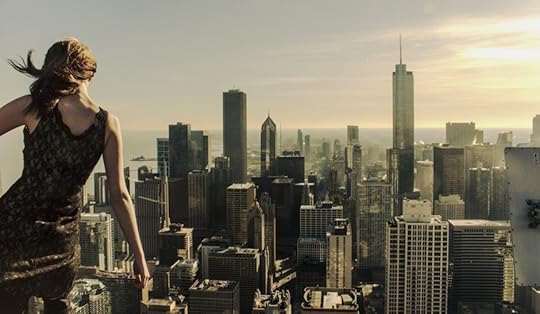
Photo: Aurelie Curie

Photo: Mustang Wanted

Matador Network's Blog
- Matador Network's profile
- 6 followers





